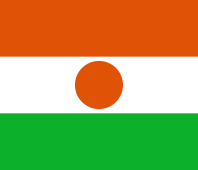Flag of Niger
 | |
| Use | National flag |
|---|---|
| Proportion | 6:7 (see below) |
| Adopted | 23 November 1959 |
| Design | A horizontal triband of orange, white and green; charged with an orange circle in the centre |
The Flag of Niger (French: drapeau du Niger) has been the national symbol of the West African Republic of Niger since 1959, a year prior to its formal independence from French West Africa. It uses the national colors of orange, white and green, in equal horizontal bands, with an orange roundel in the center. The flag forms one of the official national symbols of the Republic of Niger, with the coat of arms of Niger, the National Anthem ("la Nigérienne"), the crest (used in the center of the coat of arms), and the motto: "Fraternité, Travail, Progrès". These form Article 1 of the first part of the 1999 Constitution of Niger. The flag is similar to the Flag of India, although the ratio, shade of orange, and symbol in the center differ.[citation needed]

Legal definition[]
Prior to independence from French West Africa, the flag of Niger was adopted by the Territorial Assembly of the Niger Colony on 23 November 1959, shortly before proclamation of the Republic within the French Community on 18 December 1959. The flag was designed in 1958. It was retained upon independence in 1960 and has remained unchanged through the 1999 Fifth Constitution.[citation needed]
Symbolism[]
A number of sources have described the symbolic intent of the flag, although official sources have yet to make comment on the validity of any of the aforementioned sources. A common interpretation is that the upper orange band represents the northern regions of the Sahara Desert (though this is sometimes said to be the Sahel), the center white band represents purity (though this is sometimes said to be the Niger River) and also represents the French-descended small white minority, and the lower green band represents both hope and the fertile regions of southern Niger. The orange circle in the center band is said to represent the sun or independence.[1]
Niger's flag is a tricolour, in common with other former dependencies and colonies of France.
The official colours in RGB are as follows:
- Orange: (224, 82, 6)
- White: (255, 255, 255)
- Green: (13, 176, 43)
Ratio[]
The flag's traditional portrayal with an unusual 6:7 ratio is of unknown significance and is not used consistently in print applications of the Nigerien government.[2]

 Ratio 2:3
Ratio 2:3

 Ratio 3:5
Ratio 3:5

 Ratio 1:2
Ratio 1:2
History[]

Flag of French West Africa (1922–1959)
References[]
- ^ see Flags of the World, which cites published (foreign) sources for this. Other examples include Flags of the World 101
Susan Rasmussen Moving beyond Protest in Tuareg Ichumar Musical Performance. Ethnohistory 2006 53(4):633-655 describes Tuareg performers in orange, saying "orange symbolizes the Sahara desert" and relating it to the colors of the Nigerien flag. - ^ The FOTW for a discussion of this, and the following government websites for examples of various ratios being used official capacity:
- http://www.presidence.ne/ President of Niger
- http://www.assemblee.ne/ National Assembly of Niger
- http://www.communication-gouv-niger.ne/ Archived 2008-03-23 at the Wayback Machine Government communications office of Niger.
- Portions of this article were translated from the German language Wikipedia article de:Flagge Nigers, (consulted 2008-07-25).
- W. Smith, O. Neubecker: Die Zeichen der Menschen und Völker: Unsere Welt in Fahnen und Flaggen. Reich Verlag Luzern, 1975, ISBN 3-7243-0115-4
- Flag of Niger at FOTW, (consulted 2008-07-25).
Further reading[]
- Chaïbou, Maman (2009). "Le drapeau national". Les attributs de la République. Collection Éducation à la citoyenneté (in French). v.3. Niamey, Niger. OCLC 656089538.
- National symbols of Niger
- Flags introduced in 1959
- Flags of Africa
- National flags



